Helpful Guides on each Category
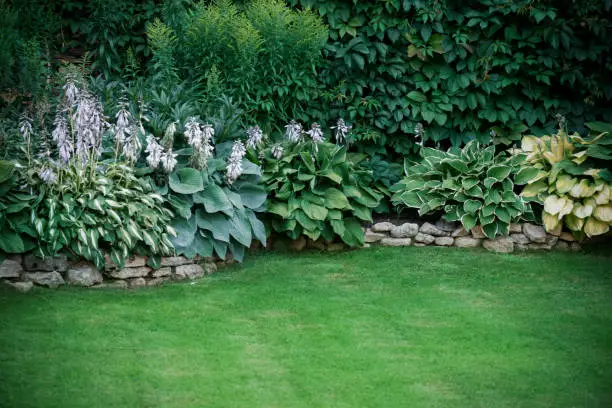
Blue hosta plants, known for their captivating hues and lush foliage, have gained widespread admiration among garden enthusiasts. Originating from East Asia, these plants have found their way into gardens around the world, gracing landscapes with their distinctive beauty.
Hosta plants are known for their wide range of foliage colours, including shades of green, blue, yellow, gold, white, and variegated combinations of these colours.
To have a blue hosta growing in your environment, you need to propagate a blue hosta, If your hostas are other colours, it is because you didn’t grow the right colour of hostas you need or there might have been a cross-pollination that brings out a variegated specie.
This guide by Agriculturist Edet, Ubok-Obong will teach you everything you need to know about this beauty, ensuring your blue hostas flourish in all their glory.
Blue hosta Quick Overview tabular format
| Family | Asparagaceae |
| Mature Plant Height | 6 inches to 3 feet |
| Growth rate | Slow |
| Light | Full Shade |
| Soil Type | Loamy, Well-Draining |
| Soil pH | 6.0 to 7.0 |
| Watering | Moderate |
| Temperature | 60°F to 75°F (15°C to 24°C) |
| Toxicity | Non-Toxic |
| Hardiness Zones | USDA 3-9 |
| Pests | Deer, Slugs, Snails |
| Diseases | Anthracnose, Rot |
Also Read on: Fishbone Cactus: Plant Care, Info, Pruning and Growing Guide
Physical Appearance of Blue Hosta Plants
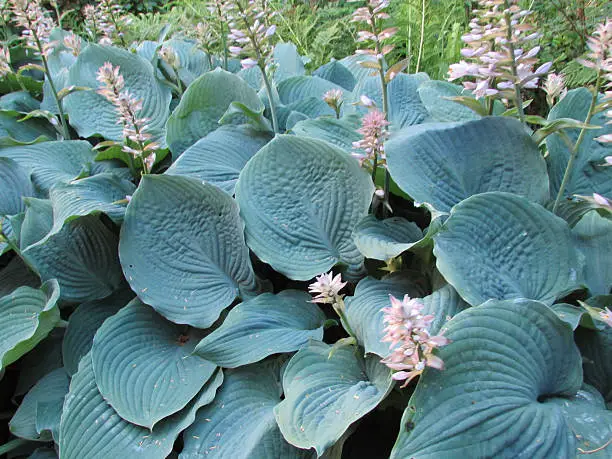
Blue hosta plants are known for their unique and inviting physical features. Their foliage is the star of the show, boasting a remarkable range of blue-green shades that can vary from a delicate silvery blue to a deep, rich navy.
The leaves are typically broad and heart-shaped, creating a lush and elegant presence in your garden. They can be grown in containers or pots.
But just How big are blue hostas?
Smaller varieties may have a mature height and spread of around 6-12 inches, making them perfect for border plantings or container gardens. On the other hand, larger cultivars can reach heights of 2 feet or more, with impressive leaf spreads of up to 3 feet.
Blue Hosta Plant Types (Which Blue Hosta Variety should I plant?)
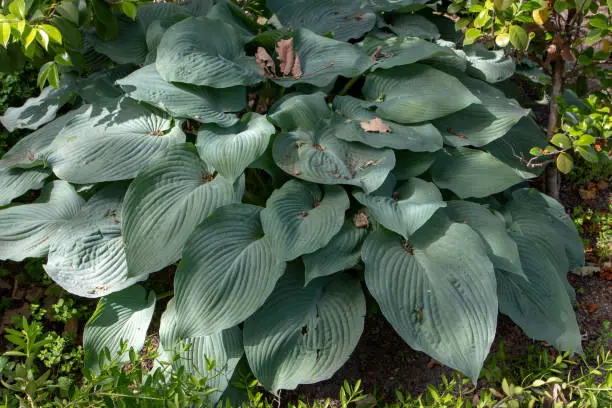
Selecting the perfect blue hosta cultivar for your garden is a crucial step in creating a visually appealing and thriving landscape. Each variety brings its unique characteristics and charm, Just consider your garden’s specific needs and your personal preferences.
Below is a list of the most popular and beautiful blue hosta varieties that should go in your garden;
- Halcyon
- Blue Angel
- Great Expectations
- June
- Blue Cadet
- Elegans
- Hadspen Blue
- Blue Mouse Ears
- Abiqua Drinking Gourd
Halcyon
This cultivar showcases a soft, powdery blue hue, making it a soothing presence in any garden. Its medium-sized leaves form neat clumps, creating a harmonious display.
Blue Angel
With enormous blue-green leaves, ‘Blue Angel’ makes a bold statement. Its striking size and colour make it a standout choice for those looking to make a dramatic impact.
Great Expectations
This cultivar takes blue hostas to the next level with variegated leaves that blend shades of blue, green, and creamy white. It’s a true showstopper in any landscape.
June
This variety stands out with striking blue-green leaves edged in creamy yellow. Its compact size and vibrant foliage make it a favorite for borders and containers.
Blue Cadet
Known for its petite size and intense blue colour, ‘Blue Cadet’ is a versatile choice for edging pathways or adding a touch of blue to smaller garden spaces.
Elegans
For those seeking a larger presence, ‘Elegans’ delivers with its broad, heavily textured blue-green leaves. It creates a bold statement in shaded garden areas.
Hadspen Blue
This cultivar offers a unique blue-gray shade and a compact growth habit, making it an excellent choice for rock gardens or as an edging plant.
Blue Mouse Ears
This mini hosta is prized for its diminutive size (2 to 3 inches long) and adorable, round blue leaves. It’s perfect for small-scale gardens or container displays.
Abiqua Drinking Gourd
This hosta is a medium-sized variety known for its deeply cupped leaves, reaching a mature height of approximately 18 inches. During midsummer, it produces elegant spikes adorned with bell-shaped white flowers, adding to its visual charm. These plants thrive in soil with an acidic pH and clay-like texture.
Planting Blue Hosta Plants
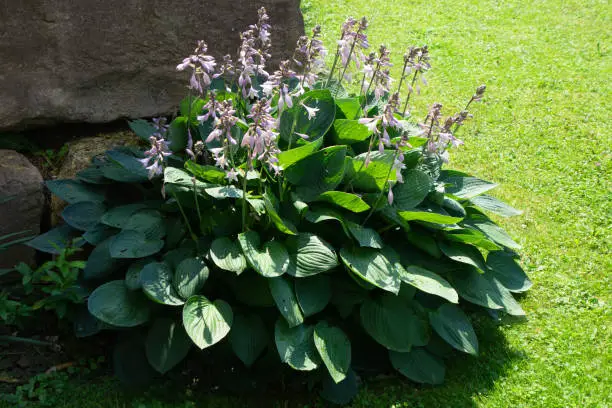
The first step to a successful blue hosta garden is choosing the ideal location for your plants. Blue hostas thrive in shaded to partially shaded areas, making them perfect candidates for woodland gardens, along the edges of trees, or as border plants in areas with filtered sunlight.
While they can tolerate some morning sun, it’s essential to provide them with protection from harsh afternoon sun, which can scorch their delicate foliage.
Begin by clearing the area of weeds and debris. A clean planting site ensures that your blue hostas won’t have to compete for nutrients and moisture.
For You: Western Sword Fern Indoors. Grow and Care Guide.
Step-by-step guide for planting blue hosta plants
- Select the blue hosta cultivars you want to plant, keeping in mind their size and growth habits to determine the spacing between plants.
- Dig holes that are approximately twice the size of the root ball of your hostas. Ensure they are spaced according to the specific requirements of the chosen cultivars.
- Place the hosta root ball in the hole so that it sits at the same depth as it was in its nursery pot. Avoid planting too deep, as this can lead to rotting.
- Gently backfill the hole with soil, pressing it down to eliminate air pockets. Water thoroughly to settle the soil and provide essential hydration to the newly planted hostas.
- Apply a layer of mulch around the base of the plants to conserve moisture, suppress weeds, and maintain a consistent soil temperature. Keep the soil consistently moist, but avoid overwatering, which can lead to root rot.
- Regularly check your blue hostas for signs of pests or diseases, such as slugs or snails, and take appropriate measures if necessary. Additionally, fertilize your hostas in early spring and mid-summer with a balanced, slow-release fertilizer to promote healthy growth.
Blue Hosta Plant Care

Watering
Blue hosta plants prefer consistently moist soil, but they don’t like to sit in waterlogged conditions. Here’s how to manage their watering needs:
Water deeply and thoroughly when the top inch of soil feels dry to the touch. Be mindful of dry spells and provide extra moisture during hot, dry periods.
Water in the morning to allow the foliage to dry before evening, reducing the risk of fungal diseases.
Use a soaker hose or drip irrigation to deliver water directly to the root zone, avoiding wetting the foliage.
Soil
Maintaining the right soil pH and texture is essential for healthy blue hostas.
Aim to keep the soil pH slightly acidic to neutral, ideally between 6.0 and 7.0. This should be a loamy and well-draining soil.
Fertilizing
Although they can thrive well without this, blue hosta plants benefit from regular fertilization to promote lush foliage and healthy growth.
Apply a balanced, slow-release granular fertilizer in early spring as new growth emerges.
A second application in mid-summer can provide an extra boost of nutrients.
Lighting/Sun/Shade
Blue hostas thrive in shaded to partially shaded conditions.
Morning sun or dappled sunlight is generally acceptable, but protect them from harsh afternoon sun, which can scorch their leaves.
Choose planting locations that receive filtered sunlight or shade throughout the day for the best results.
Temperature
Blue hostas are typically hardy in USDA Zones 3-9, but specific varieties may have different cold or heat tolerance levels.
In hot climates, provide additional shade during the hottest part of the day to prevent leaf burn.
In colder regions, mulch the base of the plants in late fall to help insulate the roots from extreme cold.
Mulching
Apply a 2-3 inch layer of organic mulch, such as shredded bark or leaf mulch, around the base of the hostas.
Ensure the mulch doesn’t touch the plant stems, as this can promote rot.
Mulch helps conserve soil moisture, regulates soil temperature, and prevents weed competition, creating an optimal environment for blue hostas.
Propagating Blue Hosta Plants
Dividing and Transplanting Blue Hostas in the Spring
The best time to divide blue hostas is in the spring or early summer. Blue hostas can also be divided in the fall, well before the first frost hits. This timing is ideal for several reasons:
- Spring is when blue hostas are actively growing, and their energy is focused on producing new foliage and roots. Dividing them during this period allowed the newly separated divisions to establish themselves quickly.
- Spring provides milder temperatures and ample moisture, which are conducive to successful division and transplanting. The plants are less stressed by extreme heat or cold.
- Dividing hostas in the spring ensures that the new divisions have ample time to develop a strong root system before winter. Cold soil in the fall can hinder root establishment, making it important to allow at least a month or two of growth before winter arrives.
Other Methods
- Seed Propagation: While it’s less common than division, blue hostas can be grown from seeds. Collect seeds from mature hosta plants in the fall and plant them in pots. They will require a period of cold stratification before germination.
- Offsets: Blue hostas can produce offsets or “pups” around the base of the mature plant. These can be carefully separated and replanted as new individual plants.
Uses of Blue Hosta plant
Blue hosta plants, prized for their striking foliage, serve several valuable purposes in gardens and landscapes:
- Ornamental Beauty
- Ground Cover
- Accent Plants
- Mixed Borders
- Understory Planting
- Pollinator Attraction
- Erosion Control
Companion plants that complement blue hostas in the garden
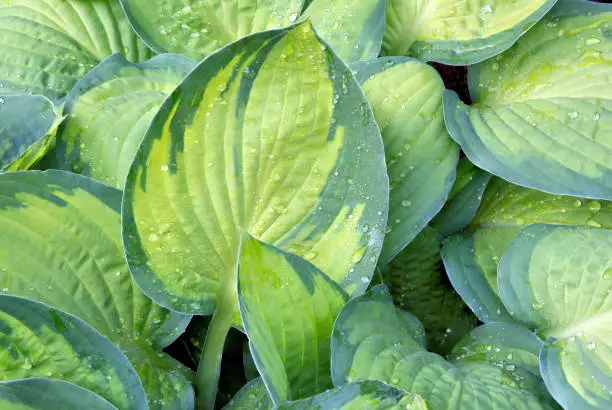
When planning a garden with blue hosta plants, it’s essential to choose companion plants that not only complement the striking blue or blue-green foliage of the hostas but also thrive in similar shade or partial shade conditions. Here are some companion plants that pair well with blue hostas:
- Astilbe (Astilbe spp.)
- Ferns
- Coral Bells
- Bleeding Heart
- Tiarella (Tiarella spp.)
- Lungwort
- Brunnera (Brunnera macrophylla)
- Lily of the Valley
- Japanese Forest Grass
- Bergenia (Bergenia spp.)
Pest and disease of blue hosta Plants
Diseases of Blue Hostas
Blue hosta plants are generally hardy, but they can be susceptible to certain diseases. Here are some common diseases to watch out for:
- Hosta Virus X (HVX): This viral disease affects hosta plants, including blue hostas. Symptoms may include irregular yellow or white streaks and mottling on the leaves. Infected plants should be promptly removed to prevent the spread of the virus.
- Fungal Leaf Spot: Various fungal pathogens can cause leaf spot diseases in hostas. These typically manifest as brown or black spots on the leaves. To manage fungal leaf spot, ensure good air circulation, avoid overhead watering, and promptly remove and destroy infected leaves.
- Crown Rot: Crown rot is a fungal disease that can affect the base of hosta plants, causing rotting and wilting. Improve soil drainage and avoid overwatering to prevent this disease. Infected plants should be removed.
- Slime Mold: While not a disease, slime mold can appear on the leaves of blue hostas, creating a slimy or powdery, grayish substance. It’s generally harmless but can be unsightly. Simply wash it off with a hose or remove affected leaves.
- Nematodes: Nematodes are microscopic roundworms that can attack the roots of hosta plants, causing stunted growth and yellowing leaves. Proper soil maintenance, including avoiding soil compaction and excessive moisture, can help deter nematode infestations.
Common Pests
Blue hostas can also be susceptible to various pests. Here are some common pests to be aware of:
- Slugs and Snails
- Deer
- Voles
- Aphids
- Japanese Beetles
- Sawflies
- Thrips
Blue Hosta FAQs
One common reason is exposure to too much sunlight. Additionally, soil conditions and age can also impact the colouration of hosta leaves.
The largest blue hosta variety is often considered to be ‘Empress Wu’. Mature plants produce leaves that are 2 feet wide or more, making it one of the largest hostas available.
Factors like increased sunlight, age of the leaves, and changes in soil pH can cause them to become greener over time.
‘Halcyon‘, ‘Blue Hawaii’ and ‘Blue Cadet’ are the bluest hostas available.
Yes, blue hostas do flower. Hosta plants produce tall spikes with clusters of tubular flowers in various colors, including lavender, white, and pale purple.
Very much yes. Hostas are not typically grown for culinary purposes, but some people do consume certain parts of the plant. The young shoots, also known as “hosta shoots” or “hosta greens,” are harvested in the spring and used in salads or cooked dishes.
Blue hosta plants are a type of perennial with blue-green or bluish-grey foliage. They are called “blue” because of the distinct bluish tint of their leaves.
To keep blue hosta foliage vibrant, provide adequate shade, consistent moisture, and well-draining soil. Mulching around the base of the plants can also help retain soil moisture.
Related Links
Like and Follow our Facebook community to get more one-on-one tips to care for your plants from our experts





